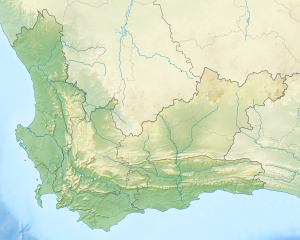Saldanha Bay
| Saldanha Bay | ||
|---|---|---|
|
Saldanha Bay from above |
||
| Waters | South Atlantic | |
| Land mass | southern africa | |
| Geographical location | 33 ° 1 ′ S , 17 ° 57 ′ E | |
|
|
||
| width | approx. 12 km | |
| depth | approx. 10 km | |
| Tributaries | Langebaan lagoon | |
|
Entrance to Saldanha Bay |
||
The Saldanha Bay is a bay on the southwest coast of South Africa and is the largest and deepest natural port in South Africa, which can be called at m by large cargo ships with a draft of up to 23rd The city of Saldanha is located on the northern bank .
The bay is partially protected by a 3.1 km long artificial breakwater and can therefore be entered by ships even in bad weather.
history
The bay is named after the Portuguese ship captain António de Saldanha , who was the first European to go ashore here in 1503.
Twice there was a confrontation between the British Royal Navy and Dutch naval units in Saldanha Bay at the end of the 18th century , in which the Dutch were defeated in both 1781 and 1796 ( surrender in Saldanha Bay ).
The northern section of the bay only developed into an industrial port, the Port of Saldanha , in the last few decades when it became necessary to facilitate the export of iron ore from the Northern Cape Province . This required the construction of the Sishen – Saldanha railway line , a stretch of more than 800 kilometers to the mines at Sishen and Kathu in the North Cape, and the construction of an offshore jetty in Saldanha Bay. Since September 1976 around 400 million tons of iron ore have been shipped through this port.
Hominin fossils
In 1997 the discovery of fossil hominine footprints of two individuals of the archaic Homo sapiens was announced, which had been discovered on the edge of the adjacent Langebaan Lagoon to the southeast and had been dated to an age of 117,000 years. About 15 kilometers east of Saldanha Bay, the relatively well-preserved skull roof Saldanha 1 was discovered by Homo rhodesiensis in 1953 .
Individual evidence
-
↑ nationalgeographic.com of August 14, 1997: Footprints Found in South Africa Come From Dawn of Modern Humans.
Rick Gore: Tracking the First of Our Kind. In: National Geographic , September 1997, pp. 92-99 - ^ Ronald Singer : The Saldanha Skull from Hopefield, South Africa. In: American Journal of Physical Anthropology. Volume 12, No. 3, 1954, pp. 345-362, doi: 10.1002 / ajpa.1330120309



